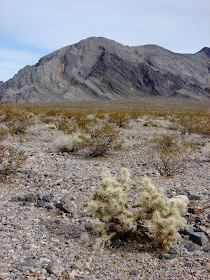 |
| Attribution: Pacific Ring of Fire 2004 Expedition. NOAA Office of Ocean Exploration; Dr. Bob Embley, NOAA PMEL, Chief Scientist: http://www.flickr.com/photos/noaaphotolib/5114735036/in/photostream/ |
This particular individual lived for several years, but during a tropical storm the turbulent water broke the stalk off, and the calyx sank to the seafloor and the crinoid died. The calyx broke into numerous calcite plates, and the organism was added to the remains of thousands of crinoids that had died before. In time the bits of stalk and little platelets were buried under the constantly accumulated debris from crinoids that were born much later. Over time the water was mostly squeezed out and the crinoid debris began to lithify, that is, it turned to solid stone. More sediment covered the limestone, providing additional pressure, and soon the remains of the small crinoid were pretty much removed from the effects of surficial processes. Then came the vast void of time. For more than 100 million years, the crinoid stalk simply existed, pretty much without change, other than a very gradual buildup of pressure as the rock was buried ever deeper under thick sequences of sand, silt and limestone.
Time ebbs and flows. Sometimes things happen very quickly, but in other situations time seems endless. The crinoid lived for only a few years, but it lay buried for millions. In this kind of immortality, sentience would be a curse. Entombed in total darkness and silence for endless millennia, insanity would be a blessing. Time wore on, and the only indications of activity were the occasional earthquake and slow change of orientation and temperature. It was also getting hotter, for big things were happening above.
The ocean had disappeared, and the rocks that had lain at the bottom of the sea were now pushed up into a mountain range. Out to the west, a subduction zone had developed, and the resulting compressional forces had buckled the rocks into a series of folds and thrust faults. A few tens of miles away, vast bodies of magma were intruding into the overlying rock, although the fragments of the crinoid were not directly effected by the igneous activity. They remained entombed in the darkness, and over time the mountains above were smoothed by erosion to a fairly muted landscape of low hills.
More millions of years passed, but the pace of change increased. There were more earthquakes, and there was an imperceptibly slow change in the amount of pressure. One day there was a crack as the stressed rock relaxed by fracturing. And then again. And then, for the first time in millions of years, water started seeping through the small fractures. The water was not salty; it was groundwater coming from rainstorms far above. Sound became more perceptible; thunder and the shattering of stones rolling down a hill.
One day, light appeared as a rock fall exposed the bit of limestone encased in what turned out to be a high cliff. A short time later, the limestone bearing the fragments of the crinoid fell out of the cliff onto the talus slope below. After the insanely slow pace of change over millions of years, events were now dazzlingly fast. One afternoon, a particularly intense thunderstorm produced a mudflow that tore away the base of the talus slope, and the chunk of rock containing the crinoid was lifted and carried in a slurry of rock and fine-grained sediment. This one storm only carried the boulder a few hundred yards, but the next storm and the one after carried the rock for several miles out onto an alluvial fan.
The rock sat, exposed to the occasional rainstorm, the endless heat of the blazing sun, and the growth of small shrubs and perennials. The surface of the rock became etched, and the structure of the original crinoid stem became obvious, enough that a semi-sentient being perceived that the one stone was different than the others nearby. He picked it up, considered the nature of the once living organism, snapped a picture, and laid the stone on the ground again. He wandered off.
300 million years after the small crinoid lived and died, the last vestiges of its existence would soon dissolve away, and its constituent atoms would be distributed through the soil. It will soon be gone.
And that is the story of the crinoid I found last month.
I've always thought about rocks this way, but in presenting the narrative in this style, I was no doubt influenced by The Planet in a Pebble: A Journey into Earth’s Deep History by Jan Zalasiewicz, which I reviewed a while back. Strangers in a Strange Land is my series on the geology revealed during a series of trips to Death Valley and the Mojave National Preserve in February and March.



Wonderful crinoid story. They are seen at the canyon in the Kaibab limestone. I gather them in the forest, outside the park, and have made a necklace with some turquoise like the Natives did.
ReplyDeleteWhat a lovely way to start my day this morning. Thanks for a wonderful and educational posting!
ReplyDeleteGreat post, most enjoyable. thanks!
ReplyDelete